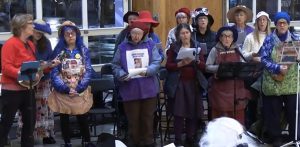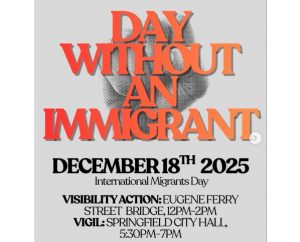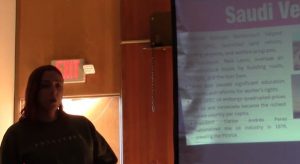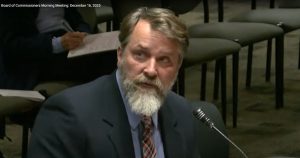Southeast Eugene looks at cargo bikes for disaster relief
7 min read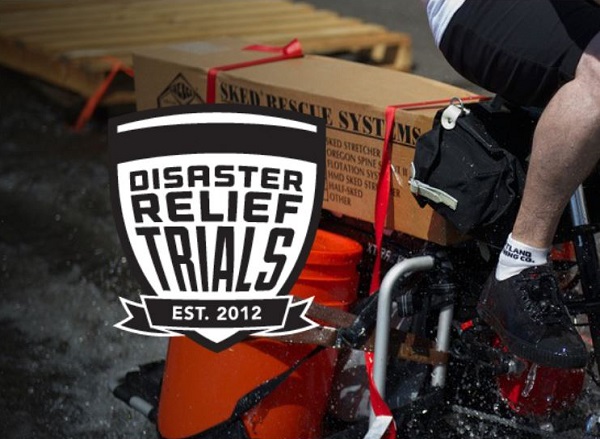
The Southeast Neighbors Transportation Committee talks about upcoming changes at LTD, speeding and pedestrian safety, and cargo bikes for disaster relief.
[00:00:11] Daniel Wilson: Professionally, I’m involved with the micromobility project that’s going on at the City. And then until recently I’ve been involved with the Active Transportation Committee with the City. And I’ve also been trying to organize folks to get a disaster relief trials event happening sometime soon in Eugene.
[00:00:32] Jess Roshak: Is that with the cargo bikes?
[00:00:34] Daniel Wilson: That’s right. Yeah. So yeah, there’s one happening in Portland next week, cargo bikes imagining a Day Four scenario after an earthquake, say, helping our neighbors out with cargo bikes, going and collecting water and food and that sort of thing. In Eugene, again, hasn’t happened since 2015 was the last one. It’s something I’d like to make happen.
[00:00:54] John Q: The group recalled a 2019 LTD proposal to eliminate neighborhood buses.
[00:01:00] Daniel Wilson: I came to a couple of the Southeast Neighbors meetings, right around when the whole issue of business with the (Route) 28 (elimination) was going on. I’m a telecommuter now, but I rode the bus maybe every other day, whenever I wasn’t biking.
But it’s a really complicated question, right? Because obviously there’s a lot of folks that depend on the bus very specifically in Southeast.
[00:01:20] And then, I also hear the arguments that folks at LTD were making about trying to consolidate the buses along certain routes, push people who live on those routes from not using the bus at all, because they have to go by the schedule, to all of a sudden being able to, like, just, ‘Oh, it’s going to run all the time. I’ll just go ahead and use it.’ I see that argument, but I also rode that (Route) 73 every day when it was like packed to the gills with students and folks living up the hill on Donald and yeah, it’s a really difficult question to answer with limited budget.
[00:01:55] Linda Duggan: My argument was how are people from the neighborhoods going to get downtown or get to those corridors if we don’t have any buses in our neighborhood to be able to, you know, get out of the neighborhood. And I was a Special Ed(ucation) teacher for 40 years. So I’m very much an advocate for disabled and elderly being able to have that accessibility to public transportation.
[00:02:20] Daniel Wilson: Oh yeah. Totally agree. It needs to start with as much spread as possible because if the bus isn’t there at all, then, you’re just never going to use the system at all. And then it’s a huge, huge accessibility issue for folks that depend on it. I don’t want to drive when it’s icy. I want to use the bus.
[00:02:38] Jess Roshak: One of our original members lived at the end of Martin Street and West Amazon and lived there because of the bus, because he was completely dependent on the bus route that had been there for 50 years. So he figured, why not?
[00:02:52] Well, this whole stuff comes around and he starts to speak up and speak at the meetings. And eventually he just gave up and a year into it, he decided he better get ahead of it and move because he was bus-dependent (Wow.). And so they had a casualty of this whole plan before the plan even rolled out. And it’s just the tip of the iceberg if they decide to go ahead with their plans.
[00:03:15] John Q: Jess said Transit Tomorrow misrepresented survey results.
[00:03:19] Jess Roshak: What it started with was, they were doing some surveys and the surveys themselves were sort of illegitimate. It was asking people to pick between: ‘Do you want more bus frequency or do you want more bus coverage? Which one do you want?’ Right. And you’re like, ‘Well, I already have a bus that comes a quarter-mile from my house. I want more frequency.’ And so they use those results of a survey to prove that the public would support them taking away some bus coverage to increase frequency. Overall, it was taking bus access away from people.
[00:03:50] They’ve got no north-south frequent transit routes all the way from 18th South into our neighborhood. There’s no north-south, even though we’ve got a Willamette arterial, we’ve got a Hilyard and Patterson arterial. You’ve got East and West Amazon. They don’t count those as anything, so it’s a whole swath of town, and I think it has to do with the lack of commercial activity here.
[00:04:13] But mostly our neighborhood is using the bus for essential trips and going to work and school. And while people don’t ride the bus to a job in South Eugene, they’re riding the bus from South Eugene to their work and school and doctors.
[00:04:28] John Q: Jess said their LTD board representative’s term ends in December.
[00:04:32] Jess Roshak: Don Nordin lives in Cottage Grove and we’ve pulled him in and he’s been a good advocate since we started communicating more and more, but it’s probably time for someone from Southeast Eugene to step up after his role is over and alternate with our representation. We’d love someone to be excited about advocating for buses in Southeast Eugene and excited to be in the transit world.
[00:04:55] John Q: LTD hopes to name a new general manager this month.
[00:05:00] Jess Roshak: One of the three candidates, and I think he was a very leading candidate—I don’t know who they picked—but a couple of people speaking very highly of him said that he’s from Kansas City and where he’s from, they went free buses. So there may be a GM who maybe (Maybe) sees the value in that, and that guy was, he is an innovative sort of thought leader who’s very logical and very intelligent, very smart and consistent, connect the dots from, you know, a bit of the value versus efficacy, but thinking outside the box in ways. So that gave me some hope about possible leadership.
[00:05:46] Linda Duggan: I’ve been really pushing for free buses. Corvallis has free buses and they do it through a fee on their utility bills. I feel like if Corvallis can do it, we can do it, you know? So I have been really pushing this with Matt Keating, our city councilor, too, the whole idea. There has to be support for it. And it’s a little more complicated because EWEB is not a city-owned utility. So if we were to go for a utility fee, it has to be worked out with EWEB.
[00:06:18] John Q: She would also like buses to the airport and the train station.
[00:06:23] Linda Duggan: The other thing that I’m interested in, in addition to of course saving our buses so we can get out of the neighborhood, is a continuous public transport system that could get us to the airport because right now there’s no connection at all to get to the airport. There’s no buses, no shuttles right now.
[00:06:43] To get to the train and the airport, and of course, downtown, the university, those corridors, the whole idea of a connected transportation system is something that I’m really interested in. That whole idea of a continuous connected system to be able to get to the other transportation systems.
[00:07:05] Daniel Wilson: Yeah, that last mile, it’s really awkward. You like land with Amtrak and you want to get to LTD downtown and there’s five or six blocks. And if you’ve got a suitcase or whatever it’s really awkward to get there. It seems really weird that there isn’t a connection point. And same with the airport (There’s nothing), the fact that it’s sort of an island. Yeah. The only way to get there is with a car. It’s very strange.
[00:07:27] Jess Roshak: You know, we spend $120 million on transit every year in our community, and yet we cannot get to the train station and airport.
[00:07:36] Daniel Wilson: It’s downtown, and yet it’s somehow still inaccessible. Um, yeah, it’s weird.
[00:07:42] John Q: Lucy Bambrey’s granddaughter had a request for the Committee.
[00:07:45] Lucy Bambrey: My granddaughter, they wanted to go to the museum at the U of O so the entire class walked to the Amazon Station. Okay. Took the bus downtown. And then had to do the EmX from the downtown bus station to U of O and get off there. And I said, ‘Well, why didn’t you just walk straight down Hilyard at Albertsons and get on there?’ She said, ‘I don’t know,’ and so they spent half of their day trying to get public transportation. I mean, they spent half of their field trip trying to get to the U of O museum.
[00:08:23] She said, ‘Grandma, you need to get on your committee and tell the people, well, my granddaughter had to do this just to get’— well, I will.
[00:08:31] John Q: Daniel also addressed speeding in the neighborhood.
[00:08:34] Daniel Wilson: I’m really frustrated that I live on Fox Hollow Road across the street from a park and my kids can’t go there because it’s too dangerous. We’re really fortunate to live really near a marked crosswalk but even so, my six-year-old wants to go to the playground all the time. And I’m like, sorry, honey, you can’t, you gotta, you gotta wait.
[00:08:51] The other thing that I really want to happen is more kid stuff: Kid bike rides, families with cargo bikes, collecting a few people and getting people out on rides.
[00:09:03] Jess Roshak: We would love to have you organize a cargo bike ride for our neighborhood. We can start there and do a, you know, Amazon loop with families and whatever. That’d be cool.
[00:09:15] John Q: Neighborhoods advise the City on transportation, land use, disaster preparedness, and more. To get involved, contact your neighborhood association.
